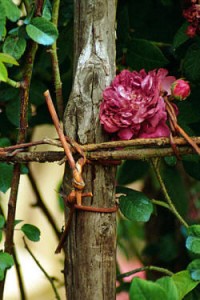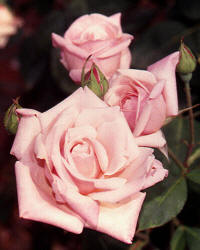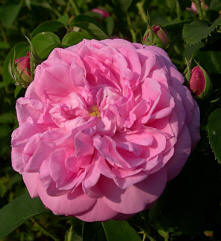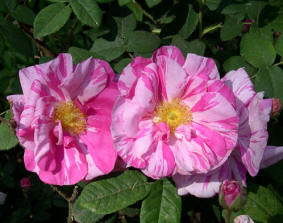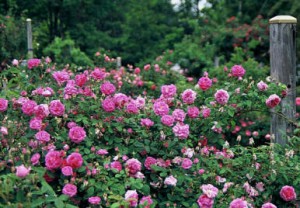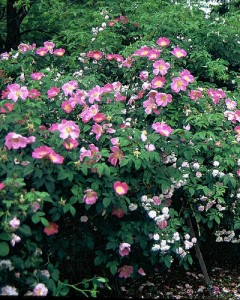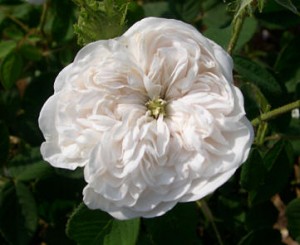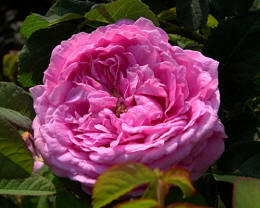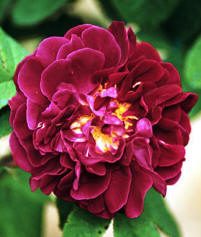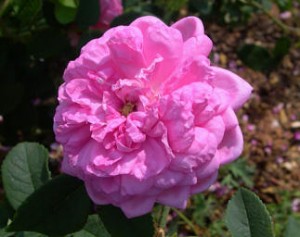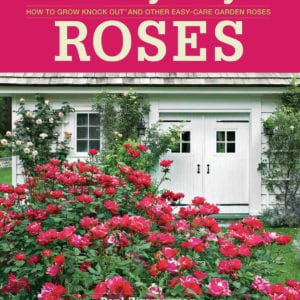Paul F. Zimmerman
Originally published in The Rose Reporter
Part 1 – What is an Old Garden Rose?
I was approached at the last meeting by someone to write an article on the care of Old Garden Roses. This rosarian was intrigued by them but would like more information on care and cultivation before she plunges into growing these kinds of roses. Naturally being an Old Garden Rose lover I think this is a good idea. Yet, as I think about it I find myself thinking why not a series of articles on OGRs in general?
We are very lucky to have the fine series of articles on obscure OGRs written by Brent Dickerson last year but outside of that we’ve not gone into specifics on this group of roses. While most of the rules of basic rose care applies to taking care of OGRs, I find tricks from sub-class to sub-class assist with blooming, health, growth and so on. These are not Hybrid Teas and as such they need some different, but not more complicated, treatment. Also since Eve Jones has now assumed the mantle of all knowing and all wise novice rose growing writer I find myself with some time to indulge myself in my writing. With all this in mind here we go.
This first article will cover Old Garden Roses as a general group. In subsequent issues I’ll go into each class and make recommendations of varieties and care.
I was first introduced to Old Garden Roses by Steve Jones at a meeting of the LA Rose Society all these years ago. I attended a meeting hoping to learn something about the three hybrid teas that recently had found their way into my garden. (Pristine, Olympiad and Sterling Silver if I remember correctly). The meeting was interesting with lots of information about roses and rose growing. Then Steve was introduced. He began speaking about roses with fragrance, lots of petals; roses that climbed, scrambled and rambled. My interest perked up and when he began showing slides my heart was gone. After many inquiries June Gross was kind enough to point me towards Bob Edberg at Limberlost Roses and before I knew it Hundred Acre Woods, Ashdown Roses and a love affair with Old Garden Roses was born. Where show business lost a comic Old Garden Roses gained an admirer.
Perhaps it’s because my parents hail from Europe, Pam traces her lineage back to England, my palette loves the subtle red wines of Burgundy over the bigness of Bordeaux and my ears perk to the lilt of Irish music, these roses represent to me everything that a rose is. Fragrance, intricately designed flower forms, graceful growth habit and colors from a softer more impressionist palette. To this day I cannot put into words why I prefer them but I do. This, by the way, does not mean I do not appreciate all roses, nor does it mean I look down on rosarians who prefer modern roses as some OGR people will. We all have different tastes and none of us has the right to be judge and jury of others. I know rosarians to whom the exquisite form of a perfect hybrid tea sings. I’ve seen some myself and I can see why. Keep this in mind as I write these articles.
What is an Old Garden Rose? To history it is a rose being of a class in existence before the year 1867. Why 1867? Simple. This is the year a rose named “La France” was introduced. La France is considered to the be the first Hybrid Tea. It is the offspring of the Hybrid Perpetual “Madame Victor Verdier” with the Tea rose “Madame Bravy”. The hybridizer was Guillot and what marked La France as being different from other roses was the high centered blossom we associate with Hybrid Teas of today. The name Hybrid Tea in fact comes from a wedding of the classes of the parents of La France. A Hybrid Perpetual and a Tea rose.
Notice I use the words “class of roses” in existence before 1867. This means that even though say a particular Bourbon (a class of Old Garden Rose) was introduced after 1867 it’s still an Old Garden Rose. In fact it’s possible that an Old Garden Rose could be hybridized and introduced to the growing public today.
Class of roses also brings us to the other part of the definition of Old Garden Roses. Modern Roses refer to Hybrid Teas, Floribundas, Miniatures etc. Sub classes within the label “Modern Roses”. It’s the same with Old Garden Roses. To put it plainly, Old Garden Roses are not a class of roses but rather a group of classes that fit one definition. That definition is the class was in existence before 1867. So if you hear folks speak of Old Garden Roses then launch into Bourbons, Albas, Damasks, Teas and so on relax. They are only talking of the classes of roses that make up the group Old Garden Roses.
Before we go further I’d like to delve into the David Austin English Roses and where they belong. First off they are not Old Garden Roses and to my knowledge Mr. Austin agrees. The English roses are in my opinion a whole new class of roses and should be recognized and labeled as such. Hybrid Shrub as a moniker comes to mind. That they pay homage to the spirit of Old Garden Roses I have no doubt. That I am very fond of them, no doubts either. Nor do I doubt they are partially responsible for the revival of Old Garden Roses in this country. But they are not Old Garden Roses and they should not be grouped with them except in the garden. There they are a perfect match.
What are the classes of roses that make up Old Garden Roses? There are a lot but generally they fall into two subclasses; Antique and Old Roses. Antique Roses are those found in Europe before the very late 1700s and Old Roses are those who can trace part of their ancestry back to R. Chinensis (The China Rose) which was the first true repeat blooming rose known to the Western World and was not introduced to Europe until around 1792. While this sounds confusing and technical there is another way to separate Antique and Old Roses. Antique roses for the most part do not repeat bloom and Old Roses for the most part do. Why? Because of the influence of R. Chinensis into breeding programs. With this repeat blooming ability roses forever changed, Old Roses were born and later all of our Modern Roses. With all of this in mind here are the classes that make up the group Old Garden Roses. (There are certainly other classes and I don’t claim to be 100% correct but for the purposes of these articles these are the ones we are going to work with.
Old Garden Roses – Pre China Rose Influence
- Gallica
- Damask
- Centifolia
- Moss
- Portland (or Damask Perpetuals)
- Alba
- Rambler
Old Garden Roses – Post China Rose Influence
- Bourbon
- Hybrid Perpetual
- Noisette
- China
- Tea
The addition of ramblers to Antique Roses might raise some eyebrows but in my mind ramblers belong with this group. There are not truly species, they did exist before 1867 and for the most part they do not repeat bloom. So allow me this indulgence. The Portland/Damask Perpetual class is also a little vague in where it might belong but I’m keeping it with Old Roses instead of Antique because of the repeat bloom. They were not directly influenced by China roses but the date of their appearance and their characteristics are similar with the other Old Roses. Now you know something about the history a few words on the Old Garden Roses in general.
Old Garden Roses as a group are best used in the landscape. They are shrubs and are meant to be used as such. For the most part they have a lax growth habit. By this I mean they grow out and not up. Left to their own devices they will happily spread out in a garden and cloak themselves with blooms.
In terms of repeat blooming there are three terms I am going to use. Once-blooming which is just that; Remontant which bloom, rest and bloom again; and continuous which bloom all the time. Most Old Garden Roses fall into the first two but some of the Teas and Chinas will rival any modern rose for flower production.
Old Garden Roses cut well for the house but with the exception of some Hybrid Perpetuals you are not going to get the long stems. As a consequence they do best in bouquets with other flowers or one of my favorite, floating in bowl where the fragrance can permeate a room.
The color range of Old Garden Roses runs from white to deep red. Missing from the palette are the neon oranges and yellows of some of today’s modern roses. A characteristic I’m not sure is a bad thing. The yellows of Old Garden Roses tend to be butter yellow towards the hue of apricot. All the colors run towards the pastel side of the color spectrum but some very deep reds and purples can be found. As a group they are very fragrant with wide varieties of scent to found.
The last thing about OGRs I’ll address in this first article are the subjects of cold hardiness, ease of care and disease resistance. As a group the Antique Roses are cold hardy. Even if they die back to the ground they seem to come back year after year. Of the Old Roses the Damask Perpetuals and the Hybrid Perpetuals will withstand a winter. The others with their strong Tea and China influence are more susceptible. Please check with rosarians in your specific area on this subject.
In terms of care OGRs do not require much once you know a few tricks. Most of them don’t need to be pruned hard every winter and are not that fussy about doing things like cutting above a five leaflet group when you deadhead. Left to their own devices they will do just fine and in fact 100 year old plants have been found in cemeteries blooming away with little care other than watering. But like anything in life a little extra care can make a big difference. There are certain little things like cutting back laterals, pegging, pillaring and knowing when to deadhead I find can make a difference. As I go into the individual varieties I’ll make some recommendations and explore some techniques.
“Old Garden Roses are all disease resistant” is a statement you will hear a lot. Not always true. Like any group of roses some are and some aren’t. Some of my Bourbons are mildew magnets and some never show a sign of the stuff. Don’t believe the literature. I’ll give my recommendations on disease resistance within each class but again I advise you to check with someone who grows them in your area. They can better advise what will and will not do well in your climate.
This covers our introduction to Old Garden Roses. From here we will begin to explore the individual classes and along the way I’ll include some tips on display, care and selection. If you have something you’d like to ask please do not hesitate to contact me via Tinseltown or on the Internet at ashdown@primenet.com.
Part 2 – Gallicas, Damasks & Centifolias
Paul F. Zimmerman
Originally published in The Rose Reporter
Perhaps the oldest roses known to Western Civilization are found in the groups of Old Garden Roses known as Gallicas, Damasks and Centifolias. They are the roses spoken of by Shakespeare, shown in drawings by Redoute and used then, as now, in rose perfumes. They all have one annual spring flowering during which the bush is covered with sometimes hundreds of blooms.
One annual spring flowering seems to be a phrase which turns off most rosarians and it’s too bad. Yes, it is certainly nice to have roses that flower all year and here in Southern California it’s tempting to use only them. After all with a ten month bloom season why would we want to include a rose that only blooms for six weeks?
The answer is because these roses are unique and beautiful in their own right and deserve to be included in a garden. After all we grow camellias, azaleas and the like and they flower only once a year. This, for this gardener, is part of the inherent charm of a plant like this. They tell you spring is here, the weather is warming up and soon all the garden will be in bloom. I also look forward to seeing them. Sure I like roses that bloom all the time but there is something special about waiting a season for that one special bloom – kind of like seeing an old friend again. Also some of these roses are unique in their color, fragrance and striping. To exclude them from a garden is to miss something unique and seasonal – something that makes a garden a unique one.
If everything we planted bloomed all year then a garden would have no variety during different times of the year. Month in and month out everything will look exactly the same and the only way to tell the seasons will be to hang a calendar near the potting table. One only has to picture a garden filled with impatiens twelve months a year to begin to glimpse the horror of such a landscape. Personally I shudder at the thought.
One of the great joys and challenges of planting a garden is creating a planting scheme that rotates smoothly during the year. As a plant goes out of bloom another takes its place. Taken to it’s artistic end one can have a “blue” garden in spring, a “yellow and red” garden in the summer and a “white” garden in the fall. The once blooming roses help make this easier.
No matter if a rose is once, repeat or constant blooming they all put on their best show in the spring. Plan the garden around this thought. During the peak rose time let the roses take center stage. Then, as the once blooming roses begin to fade make sure they are underplanted with perennials to come up and provide color while the rose lends it’s foliage as a green backdrop. Another trick is to surround once blooming roses with repeat blooming ones that over the season grow large. In the spring when the roses have not yet fully grown back from their winter prune the once blooming rose helps fill the gaps not yet grown into. As the once blooming rose fades the repeat bloomers can be allowed to grow into it and again the once bloomer provides the green backdrop. With a little imagination these roses can and should be used in every garden.
The Gallicas are the most unique of this group for two reasons. First is color. They are among the only roses that delve into the true purple range of color – Cardinal de Richelieu being a good example. The other color I love in Gallicas is the deep, deep red. While I realize this color is not unique to Gallicas I feel some of the best examples of the color are to be found in this group. Tuscany Superb fills the bill with a color almost black it can be so deep.
As bushes Gallicas tend to be shorter growing to about five feet in our climate. Of course there are exceptions but as a rule these coarser leafed roses behave themselves quite well in a garden.
The other characteristic of Gallicas accounts for the brevity of this section about them. Gallicas need a winter chill to bloom. What this means is if they don’t get a certain amount of below 45 degree weather over a winter they simply will not bloom. Sadly they rarely get enough in our climate which accounts for the fact this author has not seen many in person. Most of my acquaintance with Gallicas comes from a weekend trip to New Hampshire where I saw a tremendous collection of them. Unfortunately I also saw 900 other varieties of roses that weekend so they all blurred together. So as beautiful as these roses are unless you live up in the mountains most of your efforts at growing them in Southern California will be met with frustration. The Centifolias and Damasks on the other hand do grow well here in Southern California.
The Damask roses are well known for their fragrance and in fact in Bulgaria an entire industry is built around the attar extracted from these roses. According to the noted Old Garden Rosarian Graham Thomas the precise rose is R. Damascena “Trigintipetala”. While I will not delve into details about this industry here is one interesting fact. It takes about three tons of flowers to make 2 1/4 pounds of rose attar. This translates into 1,200,000 blooms or enough roses to cover four to five acres. In the Bulgarian district of Kazanlik some 7000 acres are devoted to the growing of this one rose – quite a sight and aroma when they are in bloom!
The Damask roses tend as a group to be very fragrant, of medium height, disease resistant and white to blush pink in coloration. The most famous variety is without a doubt Madame Hardy introduced in France in 1832. While it’s perfect bloom shape is enough to make this rose well known what set’s it apart is the green button eye in the center of each bloom. The only other rose I know to carry this trait is the David Austin Rose Fair Bianca. Other beautiful damask roses are Botzaris, Celsiana, Ispahan, Leda and Omar Khayyam.
The Centifolia roses are the roses we know from the old Dutch paintings. These are the cabbage shaped blooms crammed with petals – Centifolia itself referring to a hundred petals. The blooms tend to be larger than Damask and also with great fragrance. The shrubs themselves can be very thorny and many consider their somewhat awkward growth habit to be less than ideal for the garden. The are a good candidate for planting mid border surrounded by other roses waiting to grow into them.
I personally have not seen many Centifolias in bloom but the few I have are quite stunning and unlike most other roses. Some varieties that come recommended to me are Fantin-Latour, Petite de Hollande, Juno and Unique Blanche.
The care of Damask and Centifolia roses is minimum. As they only bloom once a year deadheading is not needed because the display of hips that will follow is part of their charm. I tend to do a little deadheading early on during the main flower display for aesthetic reasons to keep the bush looking tidy during peak bloom. Pruning is optional in our Southern California climate. You can either let them grow to whatever size they want and prune back the laterals in January or you can keep them shaped to a nice height during the summer after they bloom and then prune them back to about two feet in January. The main difference between the two styles of treatment is the amount of blooms they will have come spring. The latter will give you less the former more. On the other hand the former will take up more garden space something with our long blooming season we might not be willing to do.
I realize it is difficult to surrender valuable rose space to something that does not bloom all year here in our long season but you might try finding a space. Gallicas, Damasks, Centifolias and some of the other once blooming roses are unique and no garden featuring roses would be complete with some representatives from them.
